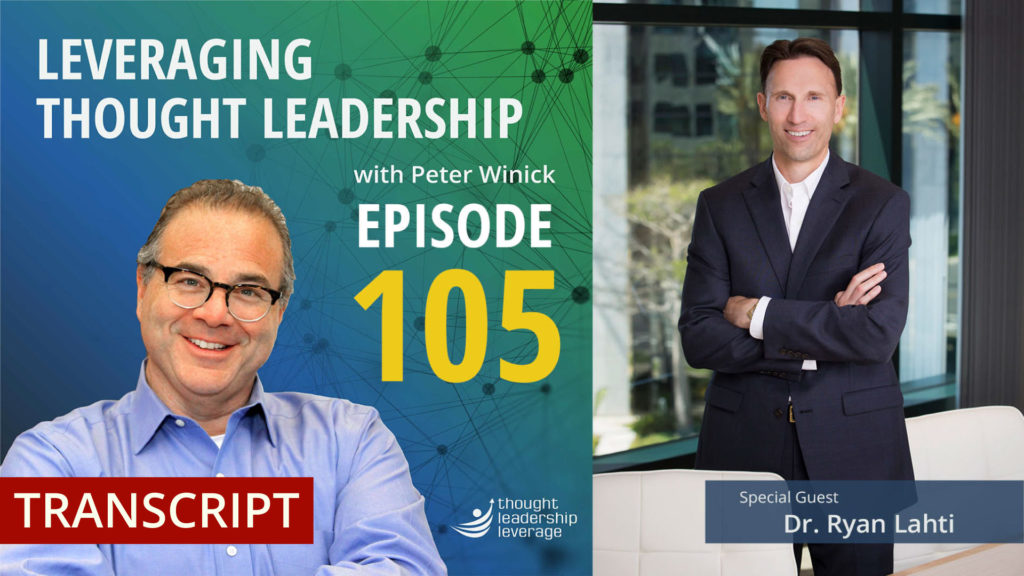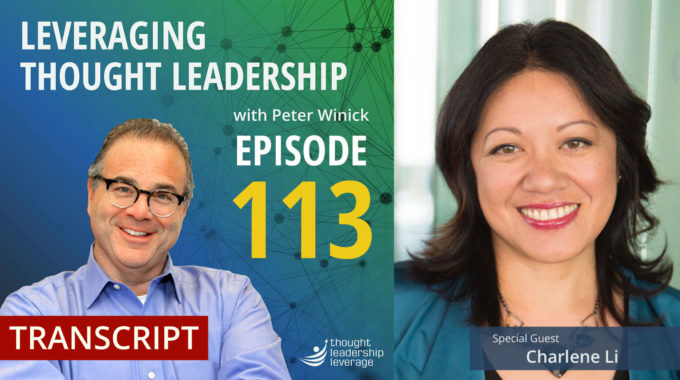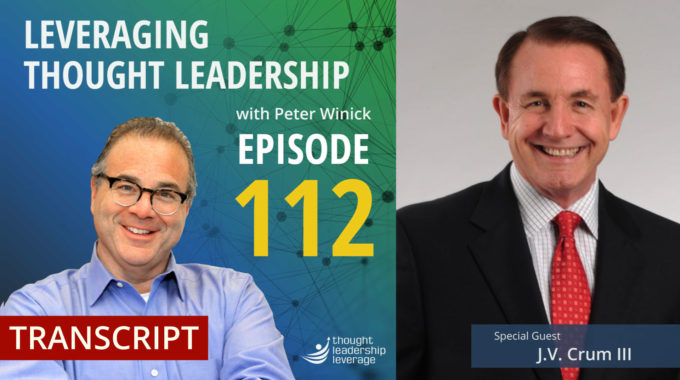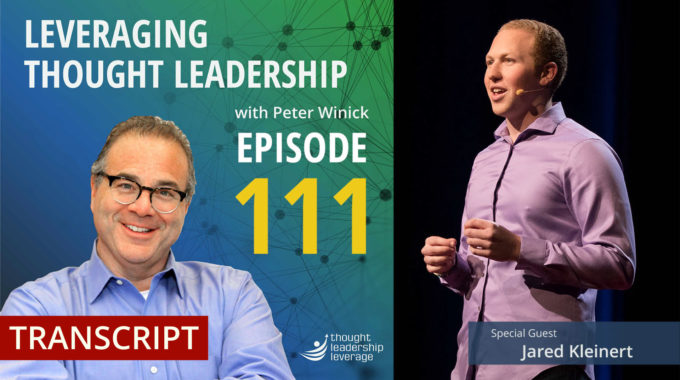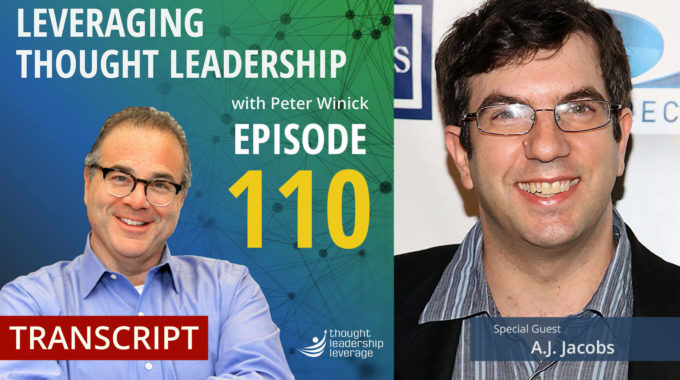Helping Your Thought Leadership Marketing Find Range, Reach, and Results. An interview with Charlene…
Thought Leadership Strategy, Social Media and Building Content | Dr. Ryan Lahti
Thought Leadership Strategy, from Content Creation to Social Media Use
An interview with Dr. Ryan Lahti about thought leadership strategy in social media use, as well as discussion of content, publication, and focus.
We interviewed Dr. Ryan Lahti, founder and managing principal of OrgLeader. Ryan is an exceptional leader who teaches his clients how to develop key capabilities, such as the seven essentials of finesse. By using proven thought leadership strategy, he enhances high-potential leaders and proven high performers who hold positions up to board of director.
Three Key Takeaways from the Interview:
- Translating your thought leadership content through many different modalities.
- Creating content that supports your social media as well as your publications.
- How leadership assessment led him to develop the seven fundamental essentials of finesse.
Transcript:
Peter And welcome, welcome, welcome. This is Peter Winick. I’m the founder and CEO of Thought Leadership Leverage, and you’re joining us on the podcast today. Today, my guest is Ryan Lahti. Actually, Dr. Ryan, like Ryan, runs a company called the Organizational Leader, the org leader. He’s the author of the upcoming book The Finesse Factor How to Build Exceptional Leaders in the STEM Organizations based on his personal experience as a strategic adviser to Fortune 500 and mid-sized companies in over 20 industries. And his sort of sweet spot is this development of finesse for organizational leaders in the stem side of the world. So, first time author and longtime consultant, welcome aboard. Right.
Dr. Ryan Lahti Well, thanks for having me, Peter.
Peter Great. So, tell us a little bit about how you got here in terms of where you were from an educational perspective, because you’ve got the PhD. And then professionally and now out on your own, doing good work and getting great work out into the world.
Dr. Ryan Lahti Happy to. Well, as far as where it started, I’ve always just been naturally curious, fascinated with how organizations operate, you know, intrigued by how they compete with different strategies, how they’re structured, you know, the systems and processes they use and especially interested in the people who actually led them. So, over the years, I’ve found that I work with a variety of different organizations in 20 plus industries. The ones that I probably most are drawn to were the ones that were technical or data driven in nature. Organizations have those attributes to some degree, but those are based on science, tech, engineering and math or STEM are the ones that rely on the most heavily. And those are the ones I typically found myself working with the most. It wasn’t necessarily intentional. I just found myself drawn to them and ended up working with them.
Peter The most interesting sort of the sort of attraction and connection to that subset.
Dr. Ryan Lahti Part of it, I think relates to I’m not someone that really I guess you could call my personal bias. I tend to want to see things that are based on evidence or rigor. So, if you come to me and tell me that while this is the approach to use with this type of organization or this leader or within this industry, that’s great. But I want to understand the why behind it. So that usually involves some sort of data or evidence. Not that to say that theory doesn’t have its place. It absolutely does. That helps everybody think in different ways. I just want something that I know will will work and that I can apply. And my clients that I work with typically are looking for that, too. So, it kind of plays into again, if you want to call that my bias, then I guess that’s my bias.
Peter But let’s move that towards the client. So, what’s interesting is you’ve got a passion here and organizational leadership could be applied in any industry. But you sort of looked at it and said, you know what, there’s a stem thing here, a stem filter, a stem lens that I could add onto my practice, not just because it’s intrinsically interesting to you, but there’s a market there. So where’s that sort of intersection of. That’s really interesting to me. And there’s a market for it. How do you sort of how did you find that?
Dr. Ryan Lahti A couple ways. Number one, a natural just kind of found myself in it just either by happenstance or just interest. But the other thing is STEM is become pretty hot. The last, you know, 10 years yet, and the way that people were looking at STEM was primarily from the if you look at it as a continuum from curricula to economies, most people were focusing on the curriculum that end of the spectrum. So, a lot of the conferences that I would go to or a lot of people that speak to it was very much focused on STEM curricula at the high school or the college level. And then, well, how do we create these STEM positions for these people with STEM skills? And from my perspective, I think that’s great, but you’re kind of missing a large part of the continuum. So where do these people go once they have these skills? Are there enough jobs and occupations? And more importantly, are these jobs and occupations in organizations that are motivating to these people said that they want to stay because a lot of those organizations are experiencing a fair amount of turnover, whether it’s in the science area, tech engineer tech or engineering area or in the finance or math area that’s across the board, which got my attention. And so, as I look more closely at it seemed like, well, there’s an opportunity here. Number one, people aren’t really talking about STEM at the organizational level. And so, as I looked around trying to figure out. So, who is really addressing this? And there was no one that really was. And there no one really talking about a STEM organization. So, I just put a stake in the ground and defined what I meant by a STEM organization. And that’s kind of how it started.
Peter Interesting. And I would imagine, given you said sort of your personal bias towards things that are evidence based. That clearly describes an attribute not universal, but across the STEM spectrum, if you will.
Dr. Ryan Lahti Very much so. I mean, STEM, you know, driven by data. Right. Technical data driven. So naturally, the scientific method comes up in a lot of areas, but it isn’t always just the pure hypothesis testing type of an approach that you would expect in a in a science arena. You can have that in a finance or banking arena or even have a credit organization insurance. And it applies across the board and even in the more creative industries, whether it’s just up the road for me in the entertainment industry or the music industry, you still have elements of that. Sure. It’s not to say there isn’t creative creativity involved in any news organization. There clearly is. And I would argue, even if you’re coming up with a new medical device, there is some innovative thinking or creativity in terms of coming up with it.
Peter So now you for eight and you woke up one day and said, I’m going to write a book. Why would one do that?
Dr. Ryan Lahti I was I had a couple of parents. They’re always saying, you know what? It just. Right. Keep writing. I always kind of like to write. I didn’t necessarily think much of it. I just like to do it. And as a part of the work that I do as a management consulting and strategic advisor, executive coach, that was helpful to help my clients or potential clients understand how I think, how I approach things. And so that was just a natural thing to move into is right. Articles are one thing, but the book itself is a different animal. It also helps to help you establish your credibility so that your more legitimate. And this was a space that kind of claimed as my own or started trying to claim as my own STEM space and the finesse space, so the book was just a natural next step. I was already kind of playing around with it, had written things in various pieces and it just made sense. Well, let’s sit down and make this a finished product.
Peter So what is it now that the book’s finished and on the cusp of coming out of the out, one format coming out and others? What did you learn along the way from the process of writing the book and not just writing and then sort of birthing it, if you will, getting it out into the universe kind of do’s and don’ts type of thing?
Dr. Ryan Lahti Yeah, yeah. I would say pro the main one is practice what you preach. If you don’t really believe in what you’re writing about, then it’s probably gonna be a long and not so fun process if you do. There’s no better way to show it than by applying what’s on your pages. So, what I wrote about in the book, I also practice myself. So, I think it adds credibility. It also helps me to refine different approaches that I use as a as it relates to the book as far as like don’t’s. I think the biggest thing that I learned and I slowly just writing with the book, but just as a practitioner and leadership development or of effectiveness and talent management is, you know, don’t try to be everything to everyone. You’ll find your interests, your specialty and focus on that. Even that means you’re putting a stake in the ground that no one else is really looked at or is questioning. Do it anyway. And then over time, you kind of build your proof of concept and establish it.
Peter And now that the book is out. What are the what is it that you’re hoping to sort of change in terms of people, the way people think, the way people find you? What are you hoping might be different if it’s a year from now when the book’s out in the universe?
Dr. Ryan Lahti I like to hear people talking using the terms that are in the book more fully. Explain them all the time. Right. So what I mean by finesse, finesse is not a new term, but that’s been out for a while. But my take on it is probably a little bit different and it’s applied in a business sense, not just in an everyday sense. So I think that would be helpful to see them using the terminology and applying it more importantly. And is it helping them become more effective at what they do as a leader or business professional? That’s the objective. Talk to me a year from now and we’ll see if that actually happened.
Peter Great. And the frameworks and models and sort of the core essence of a lot of what your consulting work is based on is in the book. Right. So how do you decide as you’re writing a book, sort of what to put in, what to put out, sort of how to connect it, the stories and data and how do you decide on that very question.
Dr. Ryan Lahti There’s been many a day and night where I have gone back and forth. Is this worthy of going the book? Is this too much? Is too little? Does it meet my test of applicability and substance or is this just a thought that crossed my mind? So that was a kind of a constant question that I always had to answer for me. Again, I went back to the data. So I based the book on my experience working in 20 plus organizations over less, you know, almost two in three decades as a starting point. You know, I noticed these patterns that keep coming up across these organizations and in STEM. And so, OK, is this really a pattern or is it just happenstance? And so as I looked at more, more and went back through all the work that I’ve done, the pattern started to become more evident. And then just to further validated my own mind, I went back and looked at 10 years worth of leadership assessment work that I had done across industries, so that having that data, both from the work done and also going back and digging through the leadership assessments, it just solidified the pattern. So that led me to the seven essentials that I had created and put into the book.
Peter Got it.
Dr. Ryan Lahti From leveraging self-awareness to getting things done through others. So that’s really what was interesting.
Peter And in terms of other ways to get that message out there, what are the other ways that your experimenting with your content in terms of maybe articles may be speaking, how you try to get people to find you get the message you’re speaking articles one.
Dr. Ryan Lahti So I do write for Forbes so that that helps. I’m a contributor there speaking out as I have opportunities to do that. Right. Podcasts, obviously I’m doing one with you. Sliced all the social media as I can, you know, through SlideShare, you know, Twitter and of course, LinkedIn, not as much of a personal use as Facebook or a variety of other social media outlets. There are people that are out there that do that much better than I do. But my main ones are Twitter and LinkedIn primarily.
Peter Right. So what’s the intersection of your preference? Facebook, not Facebook and where the folks you are trying to reach? I would imagine for your crowd, that’s sort of one and the same. Or how do you balance the with the most?
Dr. Ryan Lahti The ones that I connect with are on LinkedIn.
Peter Got it.
Dr. Ryan Lahti And Twitter. So those are and I get people contact me via those mediums. So that’s why I focus on them. Not to say that, you know, Facebook and a variety of other social media platforms aren’t good ones. They are. I just found what is the most helpful for me has been LinkedIn and then Twitter would probably be second.
Peter Got it. And you have a cadence that you follow a style. You know, obviously, Twitter is a different modality than LinkedIn. Is it experiments or how do you sort of find what’s right for you?
Dr. Ryan Lahti Are we talking in terms of articles? Are we talking more like posts or getting the content out across those mediums? Like.
Peter Right. In terms of, I would say sort of a little bit on format. A little bit. On frequency and cadence?
Dr. Ryan Lahti Well, I think there does there does need to be a consistent schedule or cadence to use your term. Otherwise, people don’t know when to look for you, when to expect you. So, I think you do have to establish that. As far as the articles that I would post on LinkedIn and Abby said as a part of that, I would also put them on Twitter to do least once a month. I used to do them much more frequently. But now that I have a variety of other things that I’m trying to do from a social media standpoint, as well as with the book and other elements in a building, I don’t have as much time to do that. So, I’m probably doing more. Posts and the posts to kind of tease people, get their interest in the concepts in the book itself. Those are three times for week and we’ll be doing it for several months.
Peter Got it. OK. And you’ve got and you’ve got a schedule that you’ve pretty much stick to until every now and then life happens. But yeah.
Dr. Ryan Lahti Absolutely.
Peter So going out on your own. How long have you had your business in its current format?
Dr. Ryan Lahti Going up on 14 years. Prior to that? I was in corporate roles and working for a large consulting firms.
Peter So let’s go back to sort of that timeframe 14 plus years ago when you decide to make the leap and go out on your own. That’s an interesting place for a lot of people, scary, challenging, etc.. Tell us a little bit of your story. You know what? I want to do my own thing and.
Dr. Ryan Lahti Well, I’ll be honest with you. I didn’t have any inkling of doing this. If you would have talked to me earlier in my career, I thought that early in my career and, you know, in college. You know, I was pondering what did I want to be when I grew up? UCLA, I thought I’d end up at a Fortune 500 company somewhere, you know, heading up leadership and org development. That was kind of the plan. No interest in ever trying to become a CEO or anything like that. I just like to do the things that I do, like you do on more effectiveness, that type of thing. As I progressed down that path and I gave a lot of credit to my experience at UCLA because I basically tried to figure out what I wanted to be when I grew up by process of elimination. I think a lot of people.
Peter So, fireman, astronaut, truck driver, all the usual kid stuff. You eliminated that early on?
Dr. Ryan Lahti Yeah, I did. I did. And fortunately, I had you know, UCLA gave me the flexibility so I could and I don’t mean to plug UCLA, but, you know, it’s my alma mater. So, it just gave me enough flexibility so I could create internships through fields study office or. And so, I did have a number of internships and figured, OK, the field where I’m really intrigued the most is how do you help organizations and the people run them be more effective at what they do. So, couple of those internships led to full time positions after college. And then as I got warmed to that and realized now, I need a lot more depth to help, you know, analyze, assess and help organizations and the leaders that run them become more effective. So, grad school is in there as well. But the biggest thing for me was I wanted exposure to a lot of different organizations in a shorter period of time. So, I went down the path. Right. Does that mean I. I look for a corporate role and incorporeal only or do I go down the consulting path? And I start down the corporate road and I realized like this industry probably is an industry for me and then thought more about it as I was in grad school and realized, you know, I think the consulting path is a better path because I can get exposure to many more organizations, many more industries in a shorter period of time. And so that’s the direction I went. The question at that point was, does that mean you go to a boutique firm? Do you go to a big four or at that time it was big six. Now it’s big for that’s. Again, I’m showing the age a little bit. So, I went to the big six route and talked of writing them in various cities throughout the country, because I wasn’t you know, in essence, I want to stay in West Coast. I was more interested in where is the best opportunity for me to grow my skill set and a number of them talk to them. And I realize, you know, when you’re talking to a couple partners that could barely fit their egos through the door, making this probably isn’t the place for me. And a couple that actually got out asked me, I won’t give you the name of the firm, but it’s one you would recognize because I was also doing my PhD full time as I was working for and working for them. And they flat out asked me, said, well, so what’s this PhD about? I said, well, it’s just a personal goal. I just want that depth. And that’s probably not going to go away. It’s just an interest of mine. And they just directly said, well, you don’t need to have that to work here. And quite honestly, my work against you. They said, OK, I appreciate the honesty. I’m probably not the guy for you then, right?
Peter Well, it tells you where the priorities are, right?
Dr. Ryan Lahti Exactly. Exactly.
Peter And time you spent studying on your PhD is a non-billable hour, which is what they’re hoping for.
Dr. Ryan Lahti Right. You’re exactly right.
Peter You have an outside interest that might better yourself or humanity. With that did it right. I won’t ask you who it was, but did a run with the shmuck center.
Dr. Ryan Lahti I plead the fifth on this one.
Peter There you go. The tape just blanked out. I don’t know how that happened.
Dr. Ryan Lahti Yeah, there. There’s an urgency. Don’t get me wrong. They are all very good firms. But yeah, I’m not going to answer the right people. Yeah, exactly.
Peter Oh, good. The right people at the right time. Well, interesting. So, as we start to. Sort of wrap up here, given your experience, sort of heavy academic background being on the corporate side, being on your own, and now sort of moving more heavily into expanding your role as sort of a thought leader, if you will. Any nuggets of advice you’d have to people like this? This is something you might want to think about or something you definitely shouldn’t do.
Dr. Ryan Lahti Well, again, I think you have to have the commitment to, you know, just grind away. You’re going to put in some long hours as you wait for any position. But if you’re writing the book or starting your own practice, it’s going to be a lot more about you and you alone. So you need to be comfortable with that. If that’s not something, I’ll just give you an example. I have a lot of corporate exacts, you know, and I also I want to I sat in the corporate role as well. So I wanted that experience, too, so I could sit on both sides of the conference room table and make me a better strategic advisor, coach and consultant. A lot of my clients, as I get later into the careers, they ask, well, so how do you learn to do or come to do what you do? I said, well, if that’s your interests, I’m happy to talk to you about it, but realize you’re only seeing a piece of it. So a lot of us say, well, it’s just about delivering the work. That’s only a third of it. So it’s also about. Right, you know, building the business and developing clients and then running the business, which they don’t see. All they see is the delivery of the wall.
Peter And quite frankly, you don’t see a lot of that early on in your career at the big firms. Right. All the other you know; the work is critical. The work is important. Delivering great client deliverables are of the utmost. But there’s a whole bunch of other squat stuff. You know, how do you find decline? How do you get a client? How do you do deal with finance and logistics and contra all the other stuff that might not be as evident to many at the larger firms. You have to own that. You have to be willing to do what it takes to get those things done as well where there is no work to do.
Dr. Ryan Lahti I absolutely agree with you. A hundred percent and to your point, they don’t really see that or realize that they figured out really quick when they go out on their own like, oh, my friend. And a lot of them. Oh yeah. Wow.
Peter Yeah, exactly. Exactly. Well, this has been great. I appreciate your time. Best of luck with the upcoming release of the book. We’ll get that in the show notes. And I appreciate your coming on board today.
Dr. Ryan Lahti Well, thanks for having me. I enjoyed it.
If you enjoyed this podcast on organizational thought leadership, check out Thought Leadership Leverage’s home page!
